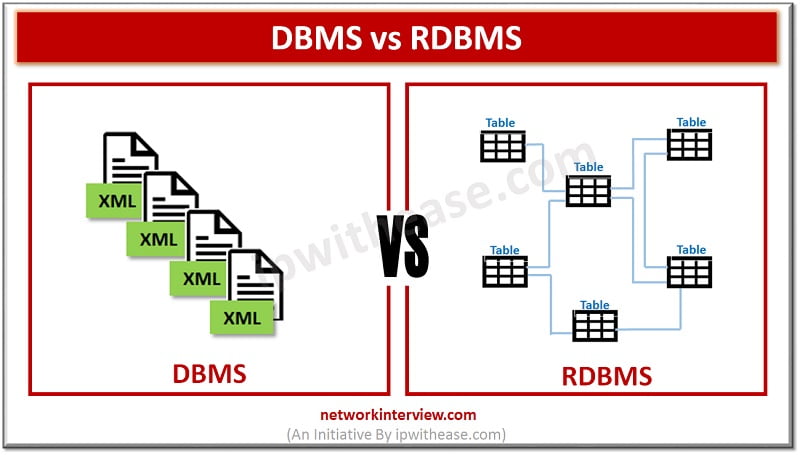
Difference between DBMS and RDBMS: Database Management Systems
The data world is constantly evolving and changing, this in turn has created a necessity to have a solution, software or technology in place to handle the data in the proper manner. The need to create and manage properly is crucial for organizations. Data management systems are often designed to handle data in effective ways. An efficient system will help in accurate recording of data, updating and tracking it, indexing so that it can be retrieved in a faster manner.
Today we look more in detail about two important terminologies: Database management systems (DBMS) and Relational database management systems (RDBMS) which are the backbone for any organization’s growth and help them to move forward in businesses and take strategic decisions related to business expansion, growth and sustainability. This article will give insight into the major difference between DBMS and RDBMS, purpose for which they are deployed and use cases.
What is DBMS?
DBMS stands for Database Management Systems. It is a software which is used to create, manipulate, and extract data from databases. Data is stored in hierarchal or navigational form in Database management systems. A file system is used to store data and there is no relationship between the tables. Database management systems perform various types of operations such as insert , update and delete data records. Database management systems don’t provide much security of data and data can’t be normalized also.
Applications of DBMS
- Railway reservation systems
- Banking industry
- Library management systems
- Credit card exchanges
- Broadcast communications
What is RDBMS?
RDBMS stands for Relational database management systems. It is an advanced model based on relational models. The tables in relational database management systems are interlinked to each other. It allows sorting, storing, organization and management of data more efficiently than the regular database management systems.
Relational database management systems support normalization in which data anomalies are removed to make the database in consistent state. It maintains data atomicity, consistency, isolation, and durability which in turn increases data integrity. Relational database management systems are more suitable for complex applications and multiple user scenarios.
Applications of RDBMS
- Used for managing inventory, stocks and payroll etc.
- Used for recording and managing day to day activities and transactions such as production, selling, income and expenses, purchases etc.
- Used for financial planning and development of business strategies
- Monitoring financial and economical state of an organization
Difference between DBMS and RDBMS
Below table summarizes the differences between the two terms:
PARAMETER | DBMS | RDBMS |
| Definition | Software which provides systematic way of creation, retrieval and management of data in databases | DBMS based on relational model introduced by E.F. Codd |
| Data storage | Data is stored in hierarchical manner or in navigational form as files | Data is stored in tables and these tables are related to each other |
| Normalization technique | Can’t perform normalization | You can perform normalization |
| Data redundancy | Provides high data redundancy | Low data redundancy as it utilizes keys and indexes in tables |
| Data storage | Data may not be stored using ACID (Atomicity, Consistency, Isolation, Durability) which are common inconsistencies in databases | Harder to create but consistent, well structured and follow ACID model |
| Data security | Less security for data when it comes to data manipulation | High security for data with multiple security levels during data manipulation. Log files are created at OS, command and object level |
| Ease of modification | Difficult to modify data | Easy to modify data |
| Characteristics | i.) More time required to access data | i.) less time required to access data |
| ii.) No keys and indexes | ii.) has keys and indexes | |
| iii.) transactions are less secure and insufficient | iii.) more secure and efficient transactions | |
| iv.) ideal for storing small amount of data | iv.) ideal for storing large amount of data | |
| v.) allows management of databases on the system hard disks and computer networks | v.) Allows maintaining relationships among tables | |
| vi.) Data elements can be accessed individually at a time | vi.) Multiple elements can be accessed at the same time | |
| vii.) supports only single user at a time | vii.) provides support for multiple users at a time | |
| viii.) don’t support distributed databases | viii.) Supports distributed databases | |
| ix.) No support for integrity constraints | ix.) Supports integrity constraints at schema level | |
| x.) client server architecture not supported | x.) supports client server architecture | |
| Softwares | Microsoft Access, Libra office, dBase, file systems etc. | MSSQL, MySQL, Oracle, SQLite , PostgreSQL Neo4J etc. |
Download the comparison table: DBMS vs RDBMS
Continue Reading:
Database and Data Warehouse : Detailed Comparison
Tag:comparison, services



